全册:北师大版九年级上册英语全册教案(word版可编辑)
- 格式:doc
- 大小:5.48 MB
- 文档页数:98
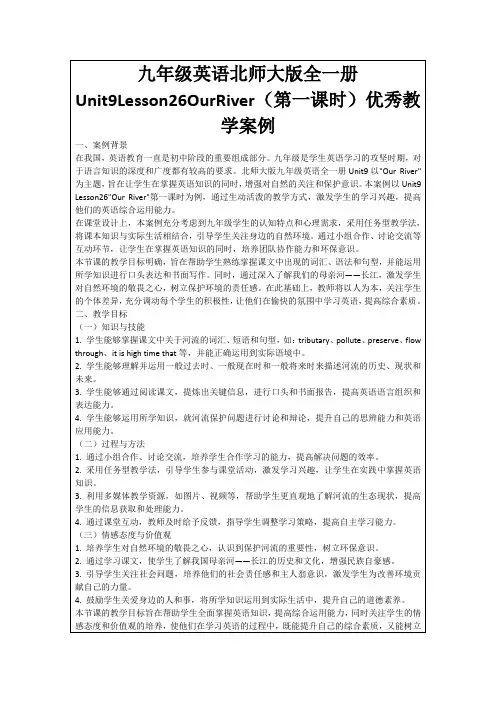
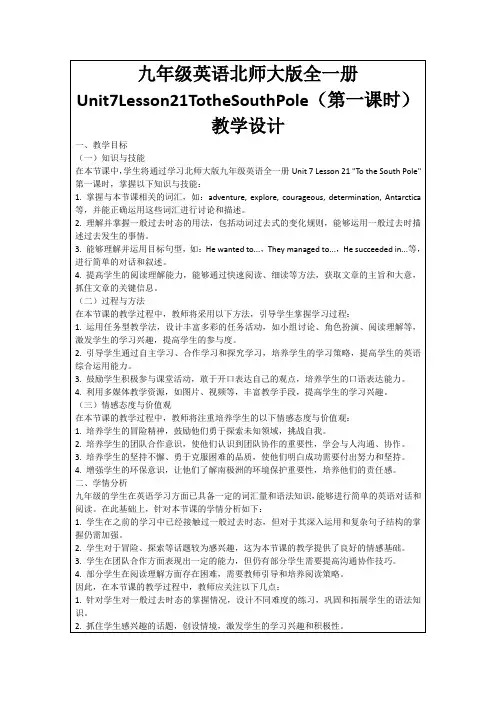
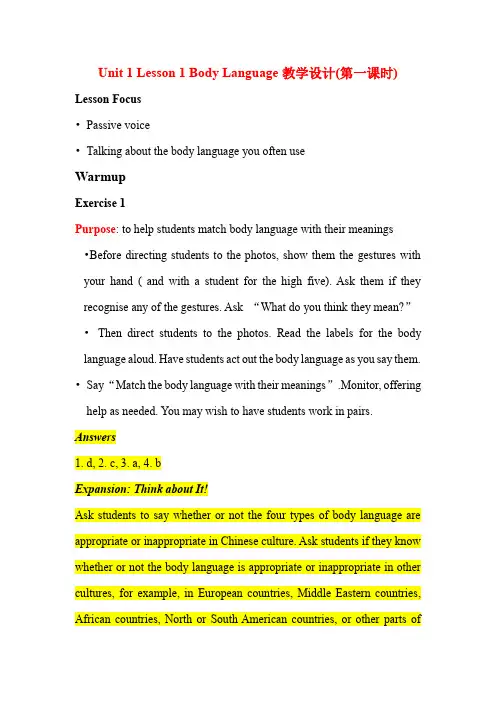
Unit 1 Lesson 1 Body Language教学设计(第一课时) Lesson Focus•Passive voice•Talking about the body language you often useWarmupExercise 1Purpose: to help students match body language with their meanings •Before directing students to the photos, show them the gestures with your hand ( and with a student for the high five). Ask them if they recognise any of the gestures. Ask “What do you think they mean?”•Then direct students to the photos. Read the labels for the body language aloud. Have students act out the body language as you say them.•Say“Match the body language with their meanings”.Monitor, offering help as needed. You may wish to have students work in pairs. Answers1. d,2. c,3. a,4. bExpansion: Think about It!Ask students to say whether or not the four types of body language are appropriate or inappropriate in Chinese culture. Ask students if they know whether or not the body language is appropriate or inappropriate in other cultures, for example, in European countries, Middle Eastern countries, African countries, North or South American countries, or other parts ofAsia.ReadingExercise 2Purpose: to help students skim a text to answer a question·Direct students to the photos. Ask “What do you think these types of body language mean?”Elicit an appropriate response, for example, They show greetings. If you feel your students are ready to do the exercise, you may skip this step.•Ask students to tell you what skimming is. Make sure students understand that skimming a text means that you read to get the general, overall idea. Say“Skim the text. What is the writer's opinion on the importance of body language?”Monitor as students read, offering help as needed.•Go over the answer, asking a student to say the answer aloud. AnswersAnswers will vary but should include the following:It's important that we learn to understand other cultures' body language. Exercise 3Purpose: to help students answer questions based on a text·Direct students to the questions. Read them aloud or have a student read them. Say“Now read the text and answer the questions”. Monitor as students read, offering help as needed.·Go over the answers, asking individual students to say them aloud. AnswersAnswers will vary but should include the following:1. Sometimes we can understand messages without words.2. Bowing in Japan, kissing in Europe, and showing your feet in the Middle East.Exercise 4Purpose: to help students plete a table based on a text•Direct students to the text. Ask " What types of body language is mentioned in the text?" Give students some time to locate and underline the types (nod their heads, put their fingers up to their mouths, shrug their shoulders, bow, kiss, shake hands). If you feel your students are ready, you may skip this step.•Direct students to the table. Say ““plete the table according to the text”. Monitor, offering help as needed. If students need support, have them work in pairs.•Go over the answers, asking individual students to say them aloud. Answersagreement; put finger up to mouth; understand, care; western cultures; respect; Asia/ Asian Countries, Japan; kiss; shake handsExpansion: Show What You Know!Show students a world map. Ask them to locate the countries mentioned inthe reading. Have them say what they learned about the body language in those countries. Ask them to share any other information they know about body language in other parts of the world.Grammar: Passive voice: present simpleExercise 5Purpose: to help students plete a table with the present simple in the passive voice•Follow these steps to teach the passive voice:⭕Carry out an action, for example, drop a pen on the floor. Ask “What am I doing?”Elicit or provide You drop a pen on the floor. (Even if students answer with the present continuous, say the sentence in simple present for illustration of this grammar point.) Write the sentence on the board. Ask “What's the subject of the sentence?”Elicit You. Then ask “What's the verb?”Elicit drop.⭕Repeat the action to introduce the passive voice. Drop your pen on the floor again. Say “I’ll tell you this time, but I’ll begin the sentence ina different way. Listen: The pen is dropped on the floor”. Write thissentence on the board. Ask students to identify the subject. Elicit The pen. Ask them to identify the verb and elicit is dropped. Underline the verb in the sentence.⭕pare the two sentences. Direct students to the first sentence and ask, “Is the subject doing the action?”Elicit Yes. Explain that the subjectis active, the one who does the action.⭕Point to the second sentence and ask, ““Is the subject doing the action?”Elicit No. Explain that the subject is passive; it is the thing having the action done to it.⭕pare what happens to the verbs. Point to the first sentence and ask,“What's the verb tense?”Elicit present simple. Then show students the verb in the second sentence: the helping verb be is used in the present tense, is, with the past participle dropped.⭕Give an example with are. Drop several pens at the same time. Ask “What am I doing? Start the sentence with The pens ...”. Challenge students to figure out they should use are instead of is this time. Elicit The pens are dropped on the floor.⭕Provide more examples by carrying out more actions. Have students tell you what you are doing, using the passive voice. For example, put some books under a chair: Books are put under a chair. Close a book:A book is closed. Write words on the board: Words are written on the boar d. Give enough examples to make students fortable with the use of simple present in the passive voice. Review past participles, if necessary.⭕Give some examples of passive voice with questions and negative statements. Carry out some actions around the classroom. For example, drop some papers on the floor and ask,““Are pens dropped on the floor?”Challenge students to answer by using the tai negative form, No. Pens aren't dropped on the floor. Papers are dropped. Write the question and negative forms on the board. Practise some more.⭕Discuss how to use the passive voice in a reallife context by directing students to the to text. Ask them to find an example of passive voice. They should indicate the first sentence. Write this on the board:Body language is used everywhere. Ask students to identify the subject and verb. Ask “Do we know who does the action?”Elicit No, we don't. Explain that in some cases, it's not important to know who does the action ——the action is more important than the““doer”of the action. In some cases, we can't know who does it. Explain that these are when we use the passive students to the sentence and ask,“Which is more important, the doer of the action or the action?”Elicit The action. ⭕Introduce an example with a by phrase. First, say the sentence in the active voice :The teacher closes the book. Then say it in the passive voice: The book is closed by the teacher. Explain that in the passive voice, the doer of the action follows the preposition by. Say“Find an example of the passive voice with a by phrase in the text”. Students should identify, in the first paragraph, Some messages are understood by people around the world ... Say the sentence in the active voice, or elicit it from your students: People around the world understand some messages ... Ask“Which is more important, the action or the doer ofthe action?”Elicit or provide The action. Explain that when we know the doer of the action, but the action is more important, we can use the passive voice with a by phrase. Have students find other sentences in the passive voice with byphrases in the reading. Then do some other actions and have students use the passive voice with a by phrase. Point out that when we have a pronoun as the subject in an active voice sentence, for example, He always kisses me on the cheek when we meet , in the passive voice, the pronoun takes the objective case: I'm always kissed on the cheek by him when we meet. Give students some more practice with changing subject pronouns to object pronouns in the passive voice.•Direct students to the example sentences. Read them aloud or havea student read them. Say "Find other sentences in the passive voice inthe text". Have students do this in pairs. Then go over the sentences, reviewing the subjects and verbs, if necessary.•Direct students to the chart. Say“Now plete the chart with the correct form of be”Monitor, offering help as needed.•Go over the answers, having individual students read the answers aloud. Encourage students to answer in plete sentence.Answeris,are,am。
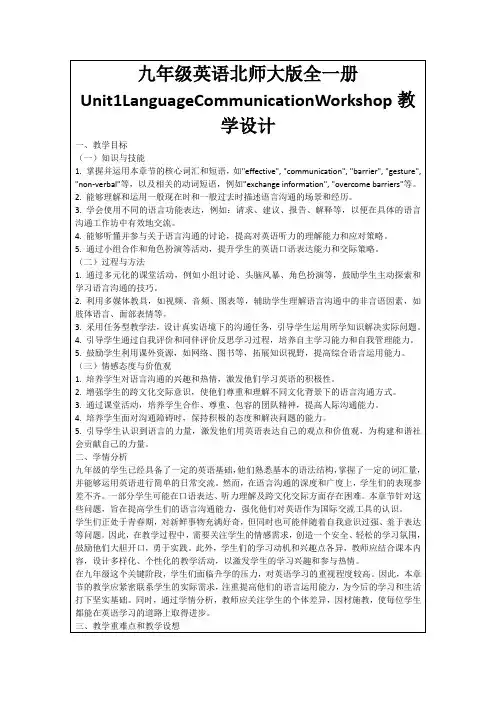
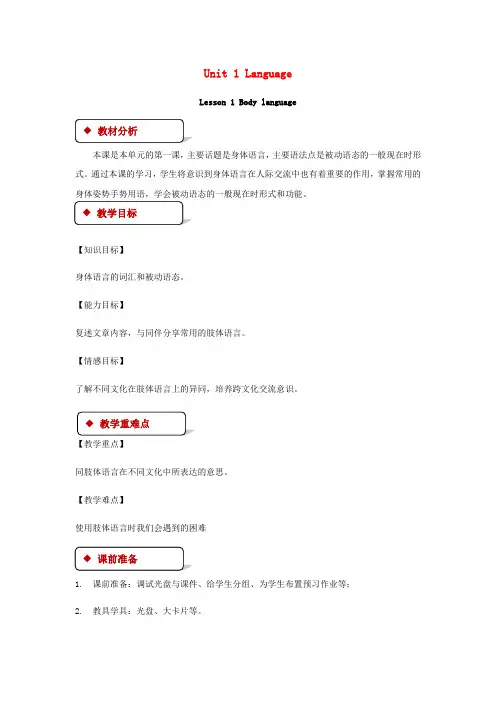
Unit 1 LanguageLesson 1 Body language本课是本单元的第一课,主要话题是身体语言,主要语法点是被动语态的一般现在时形式。
通过本课的学习,学生将意识到身体语言在人际交流中也有着重要的作用,掌握常用的身体姿势手势用语,学会被动语态的一般现在时形式和功能。
【知识目标】身体语言的词汇和被动语态。
【能力目标】复述文章内容,与同伴分享常用的肢体语言。
【情感目标】了解不同文化在肢体语言上的异同,培养跨文化交流意识。
【教学重点】同肢体语言在不同文化中所表达的意思。
【教学难点】使用肢体语言时我们会遇到的困难1. 课前准备:调试光盘与课件、给学生分组、为学生布置预习作业等;2. 教具学具:光盘、大卡片等。
1.Ask Ss a question “What languages can you speak?” to brainstorm the concerned knowledge.2.Get Ss to read key words on P5 and discuss “Which words are languages? which are nationalities? Which are both.”3. Look at the photos on P5 and discuss the questions.a. How can we pass on information?b. How many languages can you speak? What are they?c. Do you know any sign language? What gestures do you use to communicate?(e.g. thumbs up, waving your hand…)Step2. New words1.Learn new adjectives about nationality and language.Australian Canadian Indian Japanese Russian2.Learn the key words in Lesson 1.simply nod agreement finger silence differently western shoulder Asian journey taveller kiss European bottom angerStep3. Lead-in1.Let students talk about what they know about body language.2.Show some gestures via pictures and tell students what these gestures stands for in different country.3. Emphasize that body language is the most important form of communication. Step4. Warm-upMatch the body language with their meanings.Step5. Reading1.Skim the text. What is the writer’s opinion on the importance of body language?2.Read the text and answer the following questions in exercise3.plete the table in exercise 4 according to the text.Step6. Language points1.However, body language is used differently in different cultures.differently adv. 不同地;有差异地,常作状语修饰行为动词2. It is very rude to show the bottom of your shoe when you rest one leg on top of the other.本句中,it是形式主语,真正的主语是to show the bottom of your shoe。
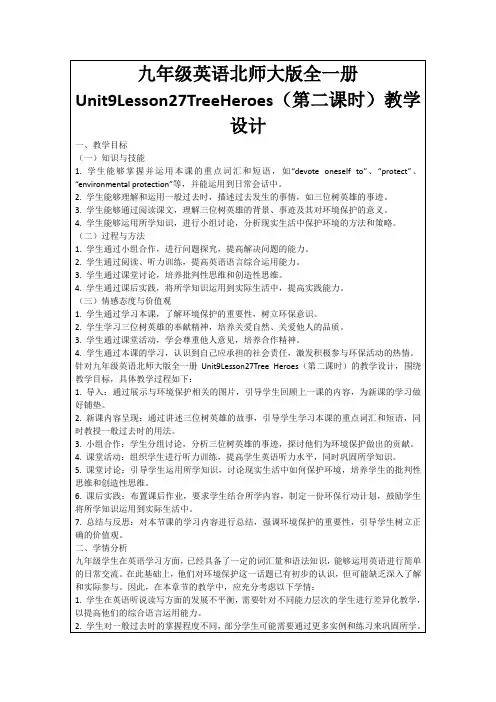

Unit 1 LanguageLesson 2 Different kinds of English本课是本单元的第二课,主要话题是英语的不同变体,尤其是英式英语和美式英语,主要语法点是反义疑问。
通过本课的学习,学生知道英式英语和美式英语在词汇选择、拼写和发音的不同,学会反义疑问句的形式和功能。
依据获取的信息展示英式英语与美式英语的不同。
【能力目标】初步体验反意疑问句的语用功能。
【情感目标】获取不同英语之间差异的信息并写出其不同点,意识到英语方言的存在。
【教学重点】听力理解英式英语与美式英语的不同。
【教学难点】反义疑问句的翻译和答语所表达的意思。
1. 课前准备:调试光盘与课件、给学生分组、为学生布置预习作业等;2. 教具学具:光盘、大卡片等。
Step1. Brainstorm1. How many kinds of English do students know? What are they? Let students discuss about the issue.2.Look at the pictures and let students look over English and American varieties referred to the same terms according to the pictures.3. Using a table to teach more different word usage between BE & AE.4. Match the words with the same meaning.5.Introduce the spelling and pronunciation between BE and AE via a table.Step2. New wordsLearn the strange words in Lesson 1.1.confused adj.2.confusing adj.3.standard n.4.native adj.。
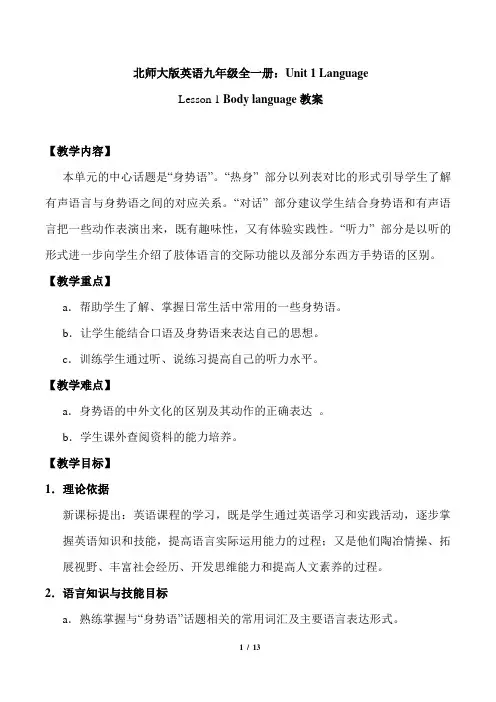
北师大版英语九年级全一册:Unit 1 LanguageLesson 1 Body language教案【教学内容】本单元的中心话题是“身势语”。
“热身” 部分以列表对比的形式引导学生了解有声语言与身势语之间的对应关系。
“对话” 部分建议学生结合身势语和有声语言把一些动作表演出来,既有趣味性,又有体验实践性。
“听力” 部分是以听的形式进一步向学生介绍了肢体语言的交际功能以及部分东西方手势语的区别。
【教学重点】a.帮助学生了解、掌握日常生活中常用的一些身势语。
b.让学生能结合口语及身势语来表达自己的思想。
c.训练学生通过听、说练习提高自己的听力水平。
【教学难点】a.身势语的中外文化的区别及其动作的正确表达。
b.学生课外查阅资料的能力培养。
【教学目标】1.理论依据新课标提出:英语课程的学习,既是学生通过英语学习和实践活动,逐步掌握英语知识和技能,提高语言实际运用能力的过程;又是他们陶冶情操、拓展视野、丰富社会经历、开发思维能力和提高人文素养的过程。
2.语言知识与技能目标a.熟练掌握与“身势语”话题相关的常用词汇及主要语言表达形式。
b.学生之间能交流、合作,共同就given topics较好地完成一些开放性话题。
c.使学生能根据key words把相关事实和信息联系起来。
3.情感态度与文化意识目标a.充分发挥情感教学的优势。
b.加强学生的团体协作意识。
c.了解东、西方文化的区别。
【教学方法】1.“任务型”教学的设计理念。
2.英语教学和情感教育的有机结合。
3.利用现代教育技术,拓宽学生学习学习和运用英语的渠道。
【设计构想】英语作为基础教育课程之一,历来备受重视。
面对新形式及新的时代要求,更应该以培养创新精神和实践能力为重点,强调新课程要促进每一位学生个体的身心发展,培养并促进学生良好品德的行成,从而使学生们能更好的适应日新月异的社会和时代。
然而,我们学生的英语能力相对比较薄弱,底子不够雄厚,学英语的态度也不够重视,导致整体的英语水平不高。
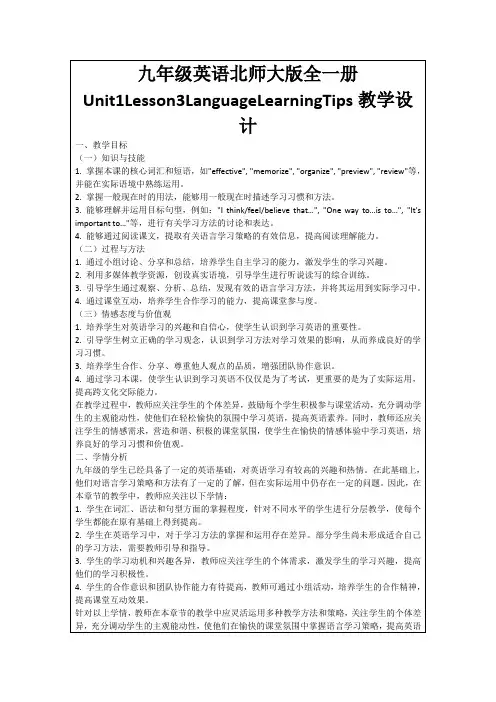
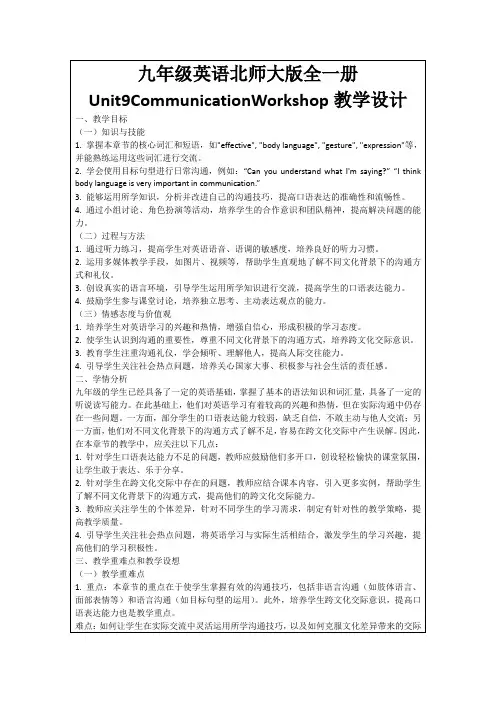
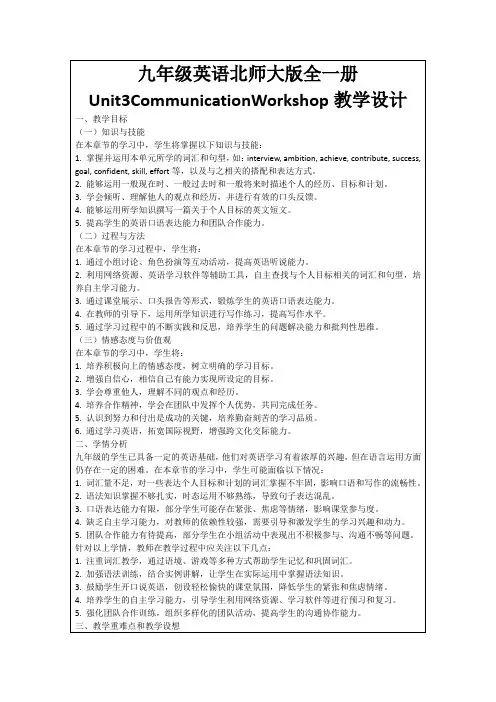
Unit 1 Lesson 3 Language Learning Tips(第一课时) Lesson Focus•Dealing with difficult words•Talking about problems in learning English and giving suggestions WarmupExercise 1Purpose: to help students in talk about what they think is difficult about learning EnglishBrainstorm aspects of learning English with your students. You may have them glance through the student book for ideas, for example, vocabulary, pronunciation, reading, listening, speaking. Ask a more proficient student“Which of these is difficult for you?”Elicit an appropriate response. Ask that student, “What do you do to help with that?”Elicit an appropriate response. You may skip this step if you feel students are ready to do the exercise.Direct students to the Example, and read it aloud or have a student read it. Then have students get into pairs or small groups. Ask“What do you think is difficult about learning English? What do you do to improve your English? Discuss with your partner / group members”e together as a class and have students share their thoughts. Expansion: Take a Poll!Note: Use this activity with more proficient students. Take a poll to seewhich are the most mon problem areas in learning English. Have students discuss how they have improved their English.ReadingExercise 2Purpose: to help students answer questions based on a textDirect students to the online discussion. Ask“What type of reading is this?”Students will most likely be able to recognise it as an online discussion. Then say““Read the first line. What's the discussion about?”Elicit David's English learning problems. If you feel your students are ready, you may skip this step.Direct students to the questions. Have students read them silently before they read the text. Then say“Read the discussion and answer the questions”. Monitor, offering assistance as needed.Go over the answers, first having students pare their answers with each other. Then ask individual students to say the answers aloud. AnswersAnswers will vary but should include the following:a. He can't remember all the new words, and he finds long passages and the language structures are difficult to understand.b. Tina says to use chants, songs and pictures to help remember new words. She also says to review new words often. Brian says, for long passages, he should try to understand the general meaning and key points first. He alsosays to use language structures, to do more reading, listening, speaking and writing. Anne says to make a list of things you do well and things you don't. Then she says to set goals and work out a learning plan to achieve them.c. She says never give up and she hopes David can find the right learning method.Exercise 3Purpose: to help students plete a table based on a textDirect students to the table. Say " Now read the text again and fill in the table". Monitor, offering help as needed. If students need support, have them work in pairs.Go over the answers, having individual students say the answers aloud.Encourage students to answer in plete sentences.AnswersTina; chants, songs and pictures; reviewBrian: the general meaning and key points first; useAnne: check learning progress; learning plan; rewardHave students discuss the text in more details.Here are some questions you can ask them:Were the suggestions similar to the ones you came up with in the Warmup? Which ones do you think you’ll try? Why? Do you agree with Mrs Smith? Why or why not?Exercise 4Purpose: to help students choose the correct meaning of words from the textAsk "Do you ever e across words in a text that are difficult to understand?" Elicit an appropriate response. Direct students to the Reading Help box. Say "Read the Reading Help. Do you ever use this strategy?" Give them respond to your question.Direct students to the words. Say " Here are some words from the reading. Find them in the reading. Use the Reading Help to understand their meanings. Then choose the correct meaning of the words".Monitor, guiding your students, as a class or individually, in using the Reading Help. First, have them find the word. Then have them identify the part of speech. Then have them read the con. text and guess the meaning. If students need support, you may have them work in pairs. Go over the answers, having individual students read them aloud. Answers1. b,2. c,3. bExercise 5Purpose: to help students discuss their opinions on suggestions for learning EnglishAsk students to recall the suggestions that Tina, Brian and Anne made.If necessary, direct them to the table in Exercise 3.Ask "Which suggestion do you think is helpful for you?" Have studentsget into pairs to discuss. Encourage them to explain their opinions, using examples of their own language learning experiences. Monitor, offering help as needed.After students have discussed their opinions, ask "What suggestion would you give to David?" Have them discuss with their partners.Monitor, offering help as needed.After students have finished, e together as a class to discuss. You may wish to take a poll to find out which suggestion students found the most helpful for themselves and which of their suggestions are the most helpful for David.Exercise 6Purpose: to help students choose the correct meaning of words from the contextDirect students to the text. Say " Use the Reading Help to figure out the meaning of the underlined words". Have students read the entire text first. Then have them read it again and choose the correct meaning of the words. Monitor, offering help as needed. If students need support, have them work in pairs.Go over the answers, having individual students read them aloud. AnswersSpeakingExercise 7Purpose: to help students discuss their English learning problems and give suggestionsAsk "What were David's problems in learning English?" Elicit He can't remember all the new words, and long passages and the language structures are difficult to understand. Then ask "Can you remember what suggestions people gave him?" Elicit a few from the reading. Ask students if they can remember some of the problems they brainstormed in the Warmup. Let students speak freely. You may allow them to makea few notes if they need support for the speaking exercise.Have students get into groups of four. Say "Now discuss your problems in learning English. Give suggestions to each other". Monitor as students talk, offering help as needed.e together as a class, having students share their thoughts. Expansion: Don't Stop!Note: Use this activity to give students more practice. Have students talk about other subjects they have trouble with. What are their problems and what suggestions can they give each other?If time allows, do Workbook pages 122 and 123 in class. Alternatively, assign for homework.。
Unit 1 LanguageLesson 3 Language learning tips本课是本单元的第三课,主要话题是语言学习过程中的学习技巧,要培养的语言能力是通过上下文来对生词意义的意义进行推测。
通过本课的学习,学生知道如何通过语境推测生词意义,掌握语言学习应该具有的技巧和方法。
通过阅读获取有关英语学习的困难及针对性建议的信息。
【能力目标】初步掌握通过上下文猜测词义的方法。
【情感目标】培养学生在学习测试过程不畏困难,勇于坚持的意志品质。
【教学重点】通过阅读获取有关英语学习的困难及针对性建议的信息。
【教学难点】进一步掌握通过上下文猜测词义的方法。
1. 课前准备:调试光盘与课件、给学生分组、为学生布置预习作业等;2. 教具学具:光盘、大卡片等。
Step1. BrainstormLet students find out what components the language learning consists of and sum up the results. Step2. Reading1.Figure out the genre of the text on P10 according to its form and content.2.Read Paragraph 1 and answer what problems David has in English learning.3. Read Paragraph 2-4 and answer what suggestions the three students reply to him.4.Focus on the three strange words in the text and let students indicate their word class and contexts.5. Guess the meaning according to the context.6.Read the text again and fill in the table in exercise 3.Step3. Guessing1.Read the passage in exercise 6 and pay attention to the context of the underlined words2.Guess the meaning of the underlined words according to the context.Step4. Language points1.It’s important to review the new words often.review v. 仔细研究;审视;细查;详查2.I always reward myself when I achieve my goals.reward v/n. 奖励;奖赏reward sb./reward sb. sth.3.I’m sure that you’ll find a learning method that suits you.suit v. 对…方便;满足…需要;合…心意sth. suit sb.4. Choose a familiar name.familiar adj. 熟悉;熟知的固定搭配:be familiar with5. Don’t read the subtitles on the screen.subtitle(常用复数) n. (外国电影的)字幕,对白译文6. jot down phrasal v. 草草记下;匆匆记下;Step5. Speaking1.Get into groups of 4. Discuss your English learning problems and give each other suggestions.2.Make a further discussion.What problems do you have in other subjects?What suggestions can you give to each other?Step6. HomeworkWrite a short passage about your partner’s problem in other subjects and your suggestions.略。
超级资源:北师大版九年级上册英语全册教案(word版可编辑)1.菱形的性质与判定(一)教学过程设计本节课设计了六个教学环节:第一环节:课前准备;第二环节:设置情境,提出课题;第三环节:猜想、探究与证明;第四环节:性质应用与巩固;第五环节:课堂小结;第六环节:布置作业。
第一环节课前准备1、教师在课前布置学生复习平行四边形的性质,搜集菱形的相关图片。
2、教师准备菱形纸片,上课前发给学生上课时使用。
第二环节设置情境,提出课题【教学内容】学生:观察衣服、衣帽架和窗户等实物图片。
教师:同学们,在观察图片后,你能从中发现你熟悉的图形吗?你认为它们有什么样的共同特征呢?学生1:图片中有八年级学过的平行四边形。
教师:请同学们观察,彩图中的平行四边形与ABCD相比较,还有不同点吗?学生2:彩图中的平行四边形不仅对边相等,而且任意两条邻边也相等。
教师:同学们观察的很仔细,像这样,“一组邻边相等的平行四边形叫做菱形”。
第三环节猜想、探究与证明【教学内容】1、想一想①教师:菱形是特殊的平行四边形,它具有一般平行四边形的所有性质。
你能列举一些这样的性质吗?学生:菱形的对边平行且相等,对角相等,对角线互相平分。
②教师:同学们,你认为菱形还具有哪些特殊的性质?请你与同伴交流。
学生活动:分小组讨论菱形的性质,组长组织组员讨论,让尽可能多的组员发言,并汇总结果。
教师活动:教师巡视,并参与到学生的讨论中,启发同学们类比平行四边形,从图形的边、角和对角线三个方面探讨菱形的性质。
对学生的结论,教师要及时评价,积极引导,激励学生。
2、做一做教师:请同学们用菱形纸片折一折,回答下列问题:(1)菱形是轴对称图形吗?如果是,它有几条对称轴?对称轴之间有什么位置关系? (2)菱形中有哪些相等的线段?学生活动:分小组折纸探索教师的问题答案。
组长组织,并汇总结果。
教师活动:教师巡视并参与学生活动,引导学生分析怎样折纸才能得到正确的结论。
学生研讨完毕,教师要展示汇总学生的折纸方法以及相应的结论,以便于后面的教学。
师生结论:①菱形是周对称图形,有两条对称轴,是菱形对角线所在的直线,两条对角线互相垂直。
②菱形的四条边相等。
3、证明菱形性质教师:通过折纸活动,同学们已经对菱形的性质有了初步的理解,下面我们要对菱形的性质进行严格的逻辑证明。
教师活动:展示题目已知:如图1-1,在菱形ABCD 中,AB=AD, 对角线AC 与BD 相交于点O.求证:(1)AB=BC=CD=AD ;(2)AC ⊥BD.师生共析:①菱形不仅对边相等,而且邻边相等, 这样就可以证明菱形的四条边都相等了。
②因为菱形是平行四边形,所以点O 是对角线AC 与BD 中点;又因为在菱形中可以得到等腰三角形,这样就可以利用“三线合一”来证明结论了。
学生活动:写出证明过程,进行组内交流对比,优化证明方法,掌握相关定理。
证明:(1)∵四边形ABCD 是菱形,∴AB = CD , AD= BC (菱形的对边相等).又∵AB=AD ∴AB=BC=CD=AD(2)∵AB=AD ∴△ABD 是等腰三角形又∵四边形ABCD 是菱形 ∴OB=OD (菱形的对角线互相平分) 在等腰三角形ABD 中,∵OB=OD ∴AO ⊥BD 即AC ⊥BD教师活动:展示学生的证明过程,进行恰当的点评和鼓励,优化学生的证明方法,提高学生的逻辑证明能力,最后强调“菱形的四条边都相等”“菱形的对角线互相垂直”,让学生A形成牢固记忆,留下深刻印象。
第四环节 性质应用与巩固【教学内容】教师:通过刚才的严格论证,我们已经认识了菱形的特殊性质,下面我们利用这些性质来解决一些问题。
教师活动:展示题目1、 例1 如图1-2,在菱形ABCD 中,对角线AC 与BD 相交2、 于点O, ∠BAD=60°,BD=6,求菱形的边长AB 和对角线3、 AC 的长。
师生共析:①因为菱形的邻边相等,一个内角4、 是60°,这样就可以得到等边△ABD ,BD=6,菱形的边长5、 也是6。
②菱形的对角线互相垂直,可以得到直角△AOB ;菱形的对角线互相平分,可以得到OB=3,根据勾股定理就可以求出OA 的长度;再一次根据菱形的对角线互相平分,即AC=2OA,求出AC 。
解:∵ 四边形ABCD 是菱形 ∴AB=AD(菱形的四条边都相等) AC ⊥BD (菱形的对角线互相垂直)OB=OD= BD = ×6 =3(菱形的对角线互相平分)在等腰三角形ABC 中,∵∠BAD=60°∴△ABD 是等边三角形 ∴AB=BD=6在Rt △AOB 中,由勾股定理,得OA 2+OB 2=AB 2OA ====2OA 2、随堂练习如图,在菱形ABCD 中,对角线AC 与BD 相交于点O. 已知AB=5cm ,AO=4cm 求 BD 的长.师生共析:从图中可以知道AC 与BD 互相垂直,可以构成直角△AOB ,因为AB=5cm ,AO=4cm ,这样就可以运用勾股定理求出OB ;又因为菱形的对角线互相平分,BD 为OB 的两倍,这样就可以很方便的求出BD 的数值了。
2121A解:∵四边形ABCD是菱形∴AC⊥BD(菱形的对角线互相垂直)在Rt△AOB中,由勾股定理,得AO2+BO2=AB2∴∵四边形ABCD是菱形∴BD=2BO=2×3=6(菱形的对角线互相平分)所以,BD的长是6cm.第五环节课堂小结【教学内容】本节课我们探讨了菱形的定义、性质,我们来共同总结一下:1、菱形的定义:一组邻边相等的平行四边形是菱形.C2、菱形的性质:①菱形是轴对称图形,对称轴是两条对角线所在的直线;②菱形的四条边都相等;③菱形的对角线互相垂直平分。
3、菱形具有平行四边形的所有,应用菱形的性质可以进行计算和推理。
【教学目的】教师鼓励学生交流课堂实践的经历、感受和收获;培养学生的归纳能力,使学生形成完整的知识结构,培养学生的自我评价能力、反思意识及总结能力。
第六环节布置作业:课本习题1.1 知识技能1、2、3 数学理解 43452222=-=-=AOABBO第三章概率的进一步认识3.1 用树状图或表格求概率(一)第一环节:温故而知新,可以为师矣问题再现:小明和小凡一起做游戏。
在一个装有2个红球和3个白球(每个球除颜色外都相同)的袋中任意摸出一个球,摸到红球小明获胜,摸到白球小凡获胜。
(1)这个游戏对双方公平吗?1(2)在一个双人游戏中,你是怎样理解游戏对双方公平的?如果是你,你会设计一个什么游戏活动判断胜负?第二环节:一花独放不是春,百花齐放春满园(1)抛掷第一枚硬币可能出现哪些结果?它们发生的可能性是否一样?(2)抛掷第二枚硬币可能出现哪些结果?它们发生的可能性是否一样?(3)在第一枚硬币正面朝上的情况下,第二枚硬币可能出现哪些结果?它们发生可能性是否一样?如果第一枚硬币反面朝上呢?请将各自的试验数据汇总后,填写下面的表格:表格中的数据支持你的猜测吗?探究体会:由于硬币是均匀的,因此抛掷第一枚硬币出现“正面朝上”和“反面朝上”的概率相同。
无论抛掷第一枚硬币出现怎样的结果,抛掷第二枚硬币时出现“正面朝上”和“反面朝上”的概率也是相同的。
所以,抛掷两枚均匀的硬币,出现的(正,正)(正,反)(反,正)(反,反)四种情况是等可能的。
因此,我们可以用下面的树状图或表格表示所有可能出现的结果:其中,小明获胜的结果有一种:(正,正)。
所以小明获胜的概率是41; 小颖获胜的结果有一种:(反,反)。
所以小颖获胜的概率也是41; 小凡获胜的结果有两种:(正,反)(反,正)。
所以小凡获胜的概率是42。
因此,这个游戏对三人是不公平的。
第三环节:会当凌绝顶,一览众山小活动内容1:准备两组相同的牌,每组两张,两张牌的牌面数字 分别是1和2.从每组牌中各摸出一张牌,称为一次试验。
(1)一次试验中两张牌的牌面数字和可能有哪些值?(2)(同位合作试验)依次统计试验30次、60次、90次的牌面情况,填写下表: 第一张牌的牌面数字 第二张牌的牌面数字第一张牌的牌面数字为1的次数第二张牌的牌面数字为1的次数 第二张牌的牌面数字为2的次数 第一张牌的牌面数字为2的次数第二张牌的牌面数字为1的次数 第二张牌的牌面数字为2的次数(3)依次统计试验30次、60次、90次时两张牌的牌面数字和分别等于2,3,4的频率,填写下表。
试验次数30 60 90 两张牌的牌面数字和等于2的频率 两张牌的牌面数字和等于3的频率两张牌的牌面数字和等于4的频率(4)你认为两张牌的牌面数字和为多少的概率最大? (5)请你估计,两张牌的牌面数字和等于3个概率是多少?(6)请你利用本节课学习的树状图或表格,计算两张牌的牌面数字和等于3个概率,验证(5)中你的估计。
解:方法一:(1)一次试验中.两张牌的牌面数字的和等可能的情况有: 1+1=2;1+2=3;2+1=3;2+2=4.共有四种情况.而和为3的情况有2种,因此, P(两张牌的牌面数字和等于3)=42=21. 两张牌的牌面数字的和有四种等可能的情况,而 两张牌的牌面数字和为3的情况有2次,因此.两张 牌的牌面数字的和为3的概率为42=21. 方法二:两张牌的牌面数字的和有四种等可能的情况, 也可以用树状图来表示而两张牌的牌面数字和为3 的情况有2次,因此.两张牌的牌面数字的和为3的概率为42=21.方法三:通过列表的方式第四环节:问渠哪得清如许 为有源头活水来活动内容:1、本节课你有哪些收获?有何感想?2、用列表法求概率时应注意什么情况?活动目的:通过对本节课的小结,加深对本节知识的理解,理解掌握树状图和列表法求理论概率的方法,并熟练应用,同时注意用列表法求概率时应注意各种情况发生的可能性务必相同。
第二张牌面数字 第一张牌面数字1212第五环节:学而时习之,不亦乐乎1. (必做题)随堂练习.2. (选做题)请同学们课后完成下面练习:(提升)小明和小颖做掷骰子的游戏,规则如下:① 游戏前,每人选一个数字:② 每次同时掷两枚均匀骰子;③ 如果同时掷得的两枚骰子点数之和,与谁所选数字相同,那么谁就获胜.(1)在下表中列出同时掷两枚均匀骰子所有可能出现的结果:1 2 3 4 5 6 1 2 3 4 5 6(2)小明选的数字是5,小颖选的数字是6.如果你也加入游戏,你会选什么数字,使自己获胜的概率比他们大?请说明理由.(探究)一个袋中有2个红球,2个黄球,每个球除颜色外都相同,从中一次摸出2个球,2个球都是红球的可能性是( )A 、 31B 、 21C 、 61D 、 41【解析】:一次摸两个球,相当于无放回的连续摸两次∴P (2个球都是红球)= =.故选C 。
四、教学反思:第2枚骰子掷得的点第1枚骰子 掷得的点3.1 用树状图或表格求概率(二)第一环节:温故知新,做好铺垫提问:上节课,你学会了用什么方法求某个事件发生的概率?1目的:通过学生回答,回想上节课主要内容,为这节课计算概率做好铺垫。